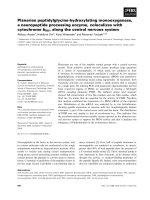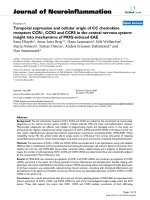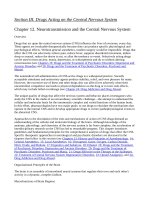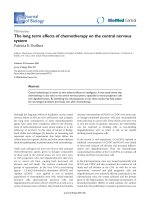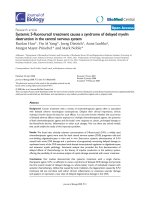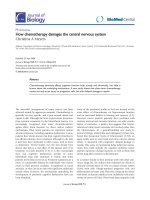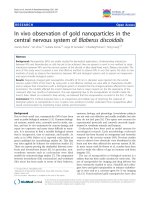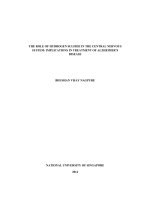Ebook King’s applied anatomy of the central nervous system of domestic mammals (2/E): Part 2
Bạn đang xem bản rút gọn của tài liệu. Xem và tải ngay bản đầy đủ của tài liệu tại đây (35.74 MB, 317 trang )
14
ExtrapyramidalFeedbackandUpperMotor
NeuronDisorders
FeedbackoftheExtrapyramidalSystem
14.1NeuronalCentresoftheFeedbackCircuits
Threemajorcentresareinvolvedinextrapyramidalfeedback,namelytheolivary
nucleus,thecerebellumandthethalamus.
14.1.1OlivaryNucleus
Theolivarynucleusisanintermediatestationonthepathwayfromthehigher
extrapyramidalcommandcentrestothecerebellum(Figure14.1).Itcorresponds
tothepontinenucleiinthepyramidalfeedbackcircuit(Figure12.2).Thesiteof
theolivarynucleusinthemedullaoblongataisshownschematicallyinFigure
8.3(seealsoFigure22.7).
Figure14.1Diagramofthefeedbackcircuitsoftheextrapyramidalsystem.The
motorcentresarenumbered1to9.Theredandblackprojectionsarethe
feedbackcircuits:theredprojectionsleadtothecerebellum,andtheblacklines
returnfromthecerebellum.Theglobuspallidusisthefocalpointof,andinthis
diagramrepresents,thebasalnuclei.Theglobuspallidushasafeedbackcircuit
throughthethalamusandcerebralcortex,whichenablesthebasalnucleito
collaboratewiththecerebralcortex.n.=nucleus;nn.=nuclei;m.r.c.=motor
reticularcentre;andr.f.=reticularformation.
14.1.2Cerebellum
Twocomponentsofthecerebellum,i.e.thecerebellarcortexandthecerebellar
nuclei(suchasthedentatenucleus),areinvolvedinextrapyramidalfeedback
circuits.Notethesimilaritytothepyramidalfeedbackcircuit(Figure12.2).
14.1.3Thalamus
Thethalamusistheintermediatestationbetweenthecerebellumandthecerebral
cortex,inthosefeedbackcircuitswhichreturntotheforebrain.Theventral
groupofthalamicnucleicontrolsallthalamicfeedbackcircuits.
Strictly,itistheventrolateralthalamicnucleus,asinthepyramidalfeedback
circuits(Figure12.2)(seeSection18.17).
14.2FeedbackCircuits
Alloftheninemotor‘commandcentres’oftheextrapyramidalsystemtogether
withthepyramidalsystemhavefeedbackcircuitsthroughthecerebellum(see
Section12.2).Thefunctionoftheseextrapyramidalfeedbackpathwaysisto
informthecerebellumoftheintendedmotoractionsoftheextrapyramidalmotor
centresandenablethecerebellumtoregulatetheseactionsastheyprogress(see
Section16.9).
Oneofthemajormotorcentresoftheextrapyramidalsystem,thebasalnuclei
(basalganglia),hasashorterfeedbackcircuitdirectlythroughthethalamusto
thecerebralcortex.Thisfeedbackcircuitenablesthebasalnucleitocarryout
theirmainrole,namelycollaborationwiththecerebralcortexviathethalamus
(seeSection13.3).
Thecerebellarfeedbackcircuitsofthenineextrapyramidalmotorcommand
centres(Nos.1to9)areasfollows:
14.2.1Centres1and2:TheCerebralCortexandGlobusPallidus
Thefeedbackpathwaystothecommandcentres1and2aresimilar,projecting
(insequence)totheolivarynucleus,tothecerebellarcortex,toacerebellar
nucleus,tothethalamus,andfinallybacktothecerebralcortex(Figure14.1).
Thesepathwaysdecussate(eitherbeforeoraftertheolivarynucleus)ontheir
waytothecerebellarcortex,andthendecussateagainonthewayback.The
circuitfortheglobuspallidusisfinallycompletedbyprojectionsfromthe
cerebralcortexbacktotheglobuspallidus(Figure14.1).
Thesepathwaysenterthecerebellumthroughthecaudalcerebellarpeduncle,
andexitthroughtherostralpeduncle(seeSections16.3and16.5).Therelayin
thethalamustakesplaceintheventralgroupofthalamicnuclei(inthe
ventrolateralnucleus,seeSection18.17).
14.2.2Centres3and4:TheMidbrainReticularFormationandRed
Nucleus
Againthesefeedbackcircuitsprojectfirsttotheolivarynucleus,thentothe
cerebellarcortex,onwardstoacerebellarnucleus,andfinallybacktothe
midbrainreticularformationandrednucleus(Figure14.1).Asbefore,theyalso
decussatetwice,i.e.onthewayinandthewayoutofthecerebellum.
Entrancetothecerebellumisgainedthroughthecaudalpeduncle,andtheoutlet
isviatherostralcerebellarpeduncle,asforCentres1and2.
14.2.3Centres5and9:TheTectumandVestibularNuclei
Centres5and9aretheextrapyramidalmotorcentresthatareassociatedwith
informationfromthespecialsenses.Theirfeedbackpathwaysmissoutthe
olivarynucleus,projectingviathecaudalcerebellarpeduncledirectlytothe
cerebellarcortex.Theyreceivereturnpathwaysfromacerebellarnucleus
(Figure14.1).Theprojectionsofthevestibularnucleitoandfromthe
cerebellumareipsilateral,andthisisuniqueamongthefeedbackpathwaysof
theextrapyramidalcentres;i.e.theleftvestibularnucleiprojectto,andreceive
returnprojectionsfrom,theleftsideofthecerebellum.Correlatethiswiththe
factthatthevestibulospinaltractdoesnotdecussate(seeSection9.3).
Thetectalpathwaystoandfromthecerebellumpassthroughtherostral
cerebellarpeduncle;theafferentandefferentvestibularpathwaysusethecaudal
cerebellarpeduncle(seeSections16.3and16.5).
14.2.4Centres6,7and8:ThePontineMotorReticularCentresthe
LateralMedullaryMotorReticularCentresandtheMedialMedullary
MotorReticularCentres
Thecommandcentresinthereticularformationofthehindbrainprojecttothe
contralateralcerebellarcortexandreceivereturnpathwaysviaacerebellar
nucleus(Figure14.1).
Allofthesepathwaysfromthehindbraincommandcentresofthereticular
formationtothecerebellumtravelinthecaudalcerebellarpeduncle(seeSection
16.3).
14.2.5FeedbackbetweenBasalNucleiandCerebralCortex
Thisfeedbackcircuitrunsfromtheglobuspallidus,totheventralgroupof
thalamicnuclei,tothecerebralcortex,andfinallybacktotheglobuspallidus
(Figure14.1).
Oftheventralgroupofthalamicnuclei,theventrolateralthalamicnucleusis
mainlyinvolvedinthisfeedbackcircuit.
14.3BalancebetweenInhibitoryandFacilitatory
Centres
AsindicatedatthebeginningofChapter13,someofthemotorcentresofthe
extrapyramidalsystemarefacilitatoryandothersareinhibitory.Thenormal
functioningofthesystemdependsonaperfectbalancebetweenthesetwo
antagonisticcomponents.
14.3.1FacilitatoryComponents
TheseareshowninFigure13.2(red),themostimportantbeing:
1. thecerebralcortexitself(relativelyrestrictedpartsofit);
2. largeareasofthebasalnuclei,especiallytheglobuspallidus;
3. therednucleus,tectumandthereticularformationofthemidbrain;
4. thepontinemotorreticularcentres;
5. thelateralmedullarymotorreticularcentresofthemedulla,whichare
strictlyinhibitorybutproducefacilitationbydisinhibitionofthemedial
medullarymotorreticularcentres(seeSection13.7);and
6. thevestibularnuclei.
14.3.2InhibitoryComponents
Themaininhibitorycomponentsoftheextrapyramidalsystemareshownin
Figure13.2(blackprojections):
1. Generally,theinfluenceofthecerebralcortexonthelowerextrapyramidal
centresappearstobeinhibitoryratherthanfacilitatory.
2. Thesubstantianigraisadenseareaofgreymatterinthecerebralpeduncle
ofthemidbrain(Figures12.1and22.13).Itreceivesprojectionsfromthe
cerebralcortex,andinturnprojectsinhibitorypathwaystothebasalnuclei
(Figure13.2).Thus,itnormallydampsdowntheactivityofthebasalnuclei.
Thisisanimportantfunction,controllingthestrongfacilitatorydriveofthe
basalnuclei,viatheglobuspallidus,uponthelowermotorcentresofthe
brainstem,andalsocontrollingtheinfluenceofthebasalnucleionthe
cerebralcortex(seeSection13.2).
3. Themedialmedullarymotorreticularcentresexertamassiveinhibitory
driveuponthedescendingreticularformationofthespinalcordbymeansof
themedullaryreticulospinaltract(seeSection13.8).
14.4ClinicalSignsofLesionsinExtrapyramidal
MotorCentresinMan
14.4.1GeneralPrinciples
Lesionsoftheextrapyramidalmotorcentres,notablyinthebasalnuclei,tend
mainlytoknockoutinhibitorycomponents:toomuchfacilitationresults,
causingincreasedmuscletone.Muchofthishypertonusseemstoarisefromthe
increasedfiringofgammaneurons,oncetheinhibitorycontrolfromabovehas
beenlifted.Thereareposturalandlocomotoryabnormalities,whichtypically
includeinvoluntarymovements,thelatterbeingknownashyperkinesia.
Usuallyspinalreflexesareexaggerated(hyperreflexia).Whenthelesionsare
unilateral,thesignstendtobecontralateral,thoughtheymaysometimesbe
bilateral.
Ifthelesionshappentoaffectmainlyexcitatorycomponentsofthe
extrapyramidalmotorcentresthenmuscletonewillbereduced,andthisdoes
happeninsomeclinicalcases.
14.4.2LesionsintheBasalNuclei
Inman,thesinglemostcharacteristicsignoflesionsofthebasalnucleiisthe
presenceofhyperkinesia.Thisconsistsofinvoluntarymovementsrangingfrom
continuoustremortosuddenjerkingmovements,andmayevenextendto
uncontrollableflailingmovementsofthearmandlegontheoppositesidetothe
lesion(hemiballismus).
Tremorisaparticularfeatureoflesionsofthesubstantianigra(seebelow,
Parkinson’sdisease).Themuchmoreviolenthyperkinesiaofhemiballismusis
usuallyassociatedwithavascularlesionofthecontralateralsubthalamic
nucleus(seeSection22.23,Subthalamus).
Hypertonus,hyperreflexiaandhyperkinesiaseemtobeamongtherelatively
simpleexpressionsoflesionsinthehuman‐basalnuclei.Muchmoreelaborate
manifestationsmayrevealthemselves.Forexample,duringwalking,theremay
begradualacceleration,sothatwhatstartsasasomewhattotterygaitturnsinto
uncontrollablerunningandendsincrashingover.Sometimesapatientappearsto
bebroughttoatotalstandstillwhenconfrontedbyadoorway,orwhenhalf‐way
upthestairs.
14.4.3Parkinson’sDisease
Thisisaparticularlywell‐knownexampleofextrapyramidaldisease.Itoccursin
manbuthasnocloseparallelindomesticanimals.Thebalancebetween
facilitatoryandinhibitoryareasisdisturbed,thefacilitatorycomponents
dominating.Increasedfusimotorneuronactivity,andhenceincreasedmuscle
tone,sometimesamountingtorigidity,isconsequentlythemainsign.Thereis
alsoafinetremorofthehands,abolishedbysleep.Usuallythelesionismainly
inthesubstantianigra.
Themechanismsbywhichthesubstantianigracontrolsmotorfunctionsarenot
known.However,ithasbeenestablishedthatthecellsofthesubstantianigraare
dopaminergic,andthatthesignsofParkinson’sdiseasecanberelievedbyL‐
dopa.Althoughnigrostriatalprojectionsappeartobethelargestdopaminergic
pathwayinthecentralnervoussystem,thereareothersextendingfromthe
substantianigratothemidbrainreticularformation,andthesemayaccountfor
someoftheundesirableside‐effectsofL‐dopa.
14.5ClinicalSignsofLesionsintheBasalNuclei
inDomesticAnimals
Itseemslikelythattheclinicalsignsarisingfromlesionsinthebasalnucleiin
domesticanimalswould,inprinciple,resemblethoseofman,i.e.hypertonus,
hyperreflexia,locomotoryandposturaldeficits,andhyperkinesia.Experimental
lesionsdosometimesproducehyperkinesia.However,thereisnotmuchfirm
informationabouttheclinicaleffectsofnaturallyoccurringlesionsinthe
domesticspecies.
Lesionsinthebasalnucleiareevidentlycommoninthedog,butitseemsvery
difficultifnotimpossibleatpresenttorelatethemtospecificneurologicalsigns.
Attemptstoproducespecificsignsinexperimentalanimalshavealsobeenrather
unsuccessful.However,smallunilaterallesionsinthecaudatenucleusincats
havebeenfollowedbycontinuousexaggeratedmovementsofthelimbsinthe
formofalternatingflexionandextensionofthepawsoftheforelimb
(resemblingthe‘knitting’movementsofaffection);thesemovements
disappearedwithsleepandduringlocomotion.Althoughthelesionswere
unilateral,thehyperkinesiaaffectedbothforelimbs,possiblybecauseofthe
midlinepathwaysofthereticularformationwhichdescendfromthebasalnuclei.
TheclinicalsignsofspasticparesisintheFriesianbullmaybepartlydueto
thelesionsthatareconsistentlyscatteredthroughoutthehighercentresofthe
extrapyramidalsystem,includingthebasalnucleiandrednucleus(aswellas
beingfoundinvariousotherpartsoftheCNS).Thecharacteristicclinicalsigns
includerigidity,orhyperkinesia,thehindlimbbeingthrownbackwardswhen
movementisattempted.Theimmediatecauseishypertonusofthe
gastrocnemiusandsuperficialdigitalflexormuscles,andinsomecasesofthe
quadricepsfemorismuscles.
Thehyperkinesia,whichcharacterizesstringhaltandshiveringinhorses,is
suggestiveofbasalnucleilesions.IngestionofplantsofthegenusCentaurea(a
knapweedfoundinNorthAmerica)byhorsesresultsinbilateral,sharply
circumscribed,necrosisofthesubstantianigraorglobuspallidus,orboth,with
facialrigidityandrhythmictongueandjawmovementsbutnotmuch
involvementofthelimbs;thehypertoniaofthefacialmusclesresemblesthatof
Parkinson’sdiseaseinman.
14.6UpperMotorNeuronDisorders
Thetermuppermotorneuron(UMN)iswidelyusedinbothhumanand
veterinaryclinicalneurology.Itissometimesconfinedtoneuronsofthe
pyramidaltract,butisoftenextendedtoincludeallthepyramidaland
extrapyramidalpathwaysthatcontrolvoluntaryactivity.Thus,thereareagreat
manypossible‘uppermotorneurons’,andthetermissoill‐definedastobea
sourceofconsiderableconfusion;indeedithasbeensuggestedthatit‘might
withadvantagebeavoided’.Nevertheless,thetermisstronglyentrenchedinthe
clinicalliteratureintheconceptof‘uppermotorneurondisorder’.
Inveterinaryneurology,lesionsofthespinalcord,whichtypicallyinvolve
manyofthedescendingmotorpathways,areconsideredtogiveclassicalsigns
ofuppermotorneurondisorder.Theseare:paralysis,orinlessseverecases
paresis,onthesideofthelesion,gaitandposturebeingobviouslyordrastically
affected;hypertonusoftheaffectedlimb(s),oftensevereenoughtobetermed
spasticity;hyperreflexiaoftheaffectedlimbs(s);andsomemusclewastingin
long‐termcases(duetoatrophyofdisuse,suchasoccursinalimbimmobilised
inaplastercast).Incontrast,theclassicalsignsoflowermotorneuron(LMN)
diseaseare:paralysis;hypotonus,oftenamountingtoflaccidity;hyporeflexiaor
areflexia;andsevereandrelativelyrapidmusclewasting(seeSection10.12).
Intervertebraldiscprotrusionsinthethoracolumbarspineofthedogclassically
resultinUMNsignsinthehindlimbs(seeSection4.9).However,ifthelesionis
intheregionofthelumbosacralintumescence,damagemayoccurtotheventral
hornlocationofthemotoneuronsinnervatinghindlimbmusculatureand
resultinginanLMNdisorder.
Hypertonusiscommonlyencounteredinuppermotorneurondisorders.Indeed,
inlong‐term,naturallyoccurringdisordersofthehighermotorcentres,ortheir
tracts,inbothmananddomesticmammals,anychangesintonearenearly
alwaysinthedirectionofhypertonus.Thereareafewexceptions,anexample
beingthehypotonusofspinalshock(seeimmediatelybelow);however,this
phenomenonisessentiallytransienteveninmanandisgenerallytooshort‐
lastingindomesticanimalstobeobservedclinically.
Themechanismofhypertonusinuppermotorneurondisordersisnotentirely
understood.However,anessentialgeneralfeatureappearstobeareleaseof
fusimotorneuronsfrominhibition.Thusthecorticospinal,rubrospinaland
reticulospinaltractsevidentlyincludefibresthatnormallyhaveatonicinhibitory
effectonfusimotorneurons.Whenthisdescendinginhibitionisremoved,
fusimotorneuronsbecomeactiveandreflexivelyinduceacontinuouspartial
contractionoftheextrafusalmusclefibresin,forexample,themusclesofthe
limbs.Thisisperceivedbytheclinicianasanincreasedresistancetothemanual
movementofthejoints,i.e.asincreasedtone.
Inseverelesionsofthespinalcord,widespreaddestructionofthewhitematter
ofthelateralandventralfuniculiononesideofthecervicalspinalcordcauses
totalparalysisoftheipsilateralfore‐andhindlimbs(hemiplegia).Ifbothsides
ofthespinalcordaredamaged,allfour“limbsmaybetotallyparalysed
(tetraplegia).Comparablelesionscaudaltothesecondthoracicsegmentofthe
spinalcordaffectthehindlimbsonly,andcangiveparalysisofonehindlimb
(monoplegia),orbothhindlimbs(paraplegia).Lessseverelesionsgiveriseto
paresis(weakness)ratherthanparalysis(i.e.hemiparesis,tetraparesis,
monoparesisorparaparesis).
Spinalshockoccursinmammalianspeciesimmediatelyaftercomplete
transectionofthespinalcord.Caudaltothelesionthereisflaccidparalysis,total
disappearanceofmuscletone(atonus),andcompletelossofreflexes(areflexia),
andthereisalsoatonyofthebladderandrectumwithretentionofurineand
faeces.Inman,thisphasegraduallyconvertsduringthefollowingweeksintoa
stageofreorganisation,inwhichthespinalcordbelowthelesionslowlyresumes
itsreflexfunctions.Inloweranimals,thisreorganisationoccursfarmorerapidly,
sothatreflexesreturnwithinanhourinthedogandwithinminutesinthe
chickenandfrog.Evidently,thelowerthephylogeneticstatusoftheanimal,the
greaterthereflexindependenceofitsspinalcord.Inveterinarypractice,the
signsofspinalshockhaveusuallydisappearedbeforethecaseisexamined
clinically.
TheSchiff‐Sherringtonphenomenonisknowntooccuronlyinthedog.
Suddencompletetransectionorcompressionofthespinalcordinthe
thoracolumbarregion(suchasmayoccurwhenadogisrunover)isfollowed
immediatelybythecompleteflaccidparalysisandareflexia,caudaltothelesion,
whichtypifyspinalshock.Inaddition,however,thereissevereandrelatively
long‐lastinghypertonusoftheforelimbs,withextensorrigidity.This
disappearsusuallywithintwoweeksoftheinjury.Clinically,thisinvolvementof
theforelimbsmaymisleadinglydirectattentiontothecervicalregionasthesite
ofthelesion,ratherthanthethoracolumbarspinalcord.TheSchiff‐Sherrington
phenomenonisbelievedtobecausedbyinterruption(atthesiteofthe
thoracolumbartransection)offibresthatnormallyariseintheventralhornofthe
lumbarspinalcord,ascendinthefasciculusproprius,andinhibitextensor
skeletomotorneuronsinthecervicalenlargementofthespinalcord.A
‘wheelbarrow’testshowsthatthecervicalspinalcordisintact,sincenormal
stepsarepossible.
15
SummaryoftheSomaticMotorSystems
Asalreadydescribed,therearetwogreatsomaticmotorsystemsintheneuraxis,
thepyramidalsystemandtheextrapyramidalsystem.
TheMotorComponentsoftheNeuraxis
15.1PyramidalSystem
Thepyramidalsystemderivesitsnamefromthefactthatitspathwaypasses
throughthewell‐definedpyramidontheventralaspectofthemedullaoblongata
(Figure22.2).Infact,the‘pyramidal’pathwaystothestriatedmuscleofthehead
(corticonuclearpathways)leavethesystembeforeitreachesthepyramid.
Thepyramidalsystemisarelativelyrecentevolutionarydevelopment.Itis
poorlydevelopedinlowermammals,andabsentinallvertebratesbelow
mammals.Becauseofitsphylogeneticyouth,itsanatomyvariesconsiderably
amongthemammalianordersandmaystillbeinanactivestateofevolution.
Thecomponentsofthepyramidalsystemarecorticonuclearpathways,
corticospinalpathwaysandfeedbackcircuits:
1. Thecorticonuclearpathwaysarisefromtheprimarymotorareaofthe
cerebralcortexandprojecttothemotornucleiofthecranialnervesthat
innervatethestriatedmusclesofthehead.Therearethreeneuronsinthe
chain,ofwhichthefirstdecussates.
2. Thecorticospinalpathwaysalsoarisefromtheprimarymotorareaand
projecttothestriatedmuscleinthebody.Thesepathwaystaketheformof
twomaincorticospinaltracts,eachwiththreeneurons.Inmanand
carnivores,thewell‐developedlateralcorticospinaltractistheprincipal
pathway,andrunsthewholelengthofthespinalcord;theventral
corticospinaltractisrelativelyinsignificantandvirtuallyconfinedtothe
neck.In‘ungulates’,theventralcorticospinaltractisthemainpathwayand
thelateralcorticospinaltractissmall;alsoaverysmalldorsalcorticospinal
tractliesinthedorsalfuniculus.However,intheungulatespecies,theentire
pyramidalsystemispoorlydevelopedandendsanatomicallyinthecervical
spinalcord.Inallofthesecorticospinalpathways,thefirstneurondecussates
soonerorlater,usuallyinthepyramid.
3. Thefeedbackcircuitsarisefromtheprimarymotorareaofthecerebral
cortex,andproceedthroughthepontinenucleitothecerebellum,thenceto
thethalamus,andfinallybacktotheprimarymotorarea.Thefirsthalfof
suchacircuit,i.e.fromthecerebralcortextothecerebellarcortex,isknown
asthecorticopontocerebellarpathway.Thecircuitdecussatesonthewayto
thecerebellumandonthewayback.
15.2ExtrapyramidalSystem
Theextrapyramidalsystemisphylogeneticallyprimitive,andwell‐developedin
allbutthelowestvertebrates.Itincludesallthoseotherdescending,somatic
motor,spinalpathways,thefibresofwhichdonotpassthroughthepyramidof
themedullaoblongata(thoughthisisnotadefinitionthatisuniversallyused).At
thetopofthebrainitarisesfromextensive,perhapsevenall,areasofthe
cerebralcortex(otherthantheprimarymotorarea).Theseareasexchange
projectionswithasequenceofmotorcentresinthelowerlevelsofthebrain,
whichculminateinspinalpathways.
Themaincomponentsoftheextrapyramidalsystemareitsmotorcentres,spinal
pathwaysandfeedbackcircuits.
1. Thereareninehighermotorcentres(thecerebralcortex,basalnuclei,
midbrainreticularformation,rednucleus,tectum,pontinemotorreticular
centres,lateralmedullarymotorreticularcentres,medialmedullarymotor
reticularcentresandvestibularnuclei).Someofthesecentresarefacilitatory,
butothersareinhibitory,theseopposinginfluencesnormallybeing
accuratelybalanced.Thebasalnuclei(notablyviatheglobuspallidus)exert
amainlyfacilitatoryinfluenceonthedescendingreticularformation.The
basalnucleialsosendevenmorenumerousprojectionstotheventral
thalamicnucleiandthencetothemotorcortex,thusstronglyregulatingthe
motorfunctionsofthecortex.Theregulationofthemotorcortexviathe
thalamusappearstobethemainroleofthebasalnuclei.
2. Fivedescendingspinaltractsarepresent(rubrospinal,tectospinal,pontine
reticulospinal,medullaryreticulospinalandvestibulospinaltracts).Ofthese,
thefirsttwodecussate,thethirdandfourthareessentiallymidline,andthe
fifthisentirelyipsilateral.Thesespinalpathwaysusuallyinvolveachainof
threeneurons.Thecellbodyofthefirstneuronisinoneofthemotorcentres
ofthebrain.Thesecondneuronisaninterneuroninthespinalcord.The
thirdneuronisamotoneuronintheventralhorn,usuallyagammaneuron.
butsometimesanalphaneuron.
3. Thefeedbackcircuitsofthehighestextrapyramidalmotorcentres,e.g.the
cerebralcortex,resemblethepyramidalfeedbackcircuit,exceptthatthey
projecttothecerebellumthroughtheolivarynucleusinplaceofthepontine
nuclei.Theextrapyramidalcentresattheintermediatelevel,e.g.thered
nucleus,stillrelayintheolivarynucleusonthewaytothecerebellum,but
theyomitthethalamusonthewayback.Theextrapyramidalcentres
involvedwiththespecialsenses,andthehindbraincentres,omitboththe
olivarynucleusandthethalamus;thesecentresthereforeprojectdirectlyto
thecerebellumandreceiveadirectprojectioninreturn.Allofthesefeedback
circuitsdecussateonthewaytothecerebellumandagainonthewayback,
exceptforthevestibulocerebellarandcerebellovestibularpathwaysthat
remainentirelyipsilateral.
15.3DistinctionbetweenPyramidaland
ExtrapyramidalSystems
Thepyramidalandextrapyramidalsystemsareactuallyalloneintegrated
system,butfordescriptivepurposesthedistinctionisstillconvenient,
anatomically,functionallyandclinically.
ClinicalSignsofMotorSystemInjuries
15.4FunctionsofthePyramidalandExtrapyramidal
Systems:EffectsofInjurytotheMotorCommandCentres
Theextrapyramidalsystemisresponsibleforthemoreorlessautomatic
muscularactivity,whichmaintainsbothpostureandalsothesemi‐volitional
deep‐rootedsomaticactivitiesofdailylife,suchaslocomotion,feedingand
defence.Thepyramidalsystemsuperimposesvoluntary,detailed,muscular
movementsuponthesemi‐automaticposturalandlocomotorybackgroundofthe
extrapyramidalsystem.
Aconsiderablecapacityforvoluntarymovementsurvivesdestructionofthe
primarymotorareaofthecortexinmanymammals(seeSection12.6).For
instance,inthedog,thereisrelativelylittledisturbancesoonafterdestructionof
theprimarymotorarea,themainabnormalitiesbeingsomedegreeofparesis
accompaniedbyhypertonusandhyperreflexiainthecontralaterallimbs.Onthe
otherhand,primatesshowseveremotordisabilityafterdestructionofthe
primarymotorarea,withflaccidparalysis(atonus)andareflexiaonthe
contralateralside,thisbeingfollowedsomehoursordayslaterbyhyperreflexia
andspasticity(hypertonus).
Inman,lesionsintheextrapyramidalmotorcentresandparticularlyinthe
basalnucleigenerallyproducehypertonus,hyperreflexia,andposturaland
locomotorydeficits.Thesinglemostcharacteristicsignofbasalnucleilesionsin
manisinvoluntarymovement(hyperkinesia).Unilaterallesionstendtogiverise
tocontralateralsigns,butbilateraldisturbancesmayresult.Thehypertonusmay
beduetotheactivityofgammaneurons,whichhavebeenreleasedfromthe
inhibitorycontrolofthehighercentres.Littleisknownabouttheeffectsof
naturallyoccurringlesionsinthebasalnucleiindomesticmammals,butthey
mightbeexpectedtoproduceclinicalsignswhich,atleastinprinciple,resemble
thoseobservedinman;experimentallesionssometimesproducehyperkinesia.
15.5UpperMotorNeuron
Theterm‘uppermotorneuron’,orUMN,iswidelyusedinclinicalneurology.It
canbeconfinedtoneuronsofthepyramidaltract,butisusuallyextendedto
includeallthepyramidalandextrapyramidalpathwaysthatcontrolvoluntary
activity.Uppermotorneurondisordersincludebothpyramidaland
extrapyramidallesions.Interruptionoftheuppermotorneuronbyspinallesions
ischaracterisedbyparalysisorparesis,withhypertonus(spasticparalysis,
spasticparesis),hyperreflexiaandgradualmusclewasting.
15.6LowerMotorNeuron
Thelowermotorneuron(LMN)isthealphaneuronoftheventralhorn(Figure
15.1).Destructionofthelowermotorneuroncausesparalysisorparesiswith
hypotonus(flaccidparalysis,flaccidparesis),reducedreflexes(hyporeflexia)or
lossofreflexes(areflexia),andsevereandrapidmusclewasting.
Itisimportanttoappreciatethatasingleinjurymayberesponsibleforamixture
ofbothUMNandLMNsigns.Forexample,alesionatC8/T1mayinduceLMN
signsinaforelimbbydamagingtheventralhornandatthesametimebe
responsibleforUMNsignsinahindlimbbydamagingdown‐goingmotor
pathways.Sincethemajorityofmotorpathwaysinthespinalcordareinhibitory,
itislikelythattherewillbeover‐facilitation,i.e.hypertonusandhyperreflexia
(UMN)inthehindlimb.ItisevenpossibletoobservebothUMNandLMN
signsinthesamelimb,dependingontheexactlocationofthelesion.
15.7SummaryofProjectionsontotheFinal
CommonPath
Thefinalcommonpathistheskeletomotorneuron(alphaneuron).Itreceives
thefollowingprojections(Figure15.1):
Figure15.1Diagramsummarisingthemainprojectionsonmotorneuronsinthe
ventralhorn.Thediagramisbasedonatransversesectionofthespinalcordat
abouttheeighthcervicalsegment.Pyramidalandextrapyramidalneuronsand
primaryafferentneurons(showninred)projectoninterneurons(black).Mostof
theseinterneurons(continuouslines)projectonthegammaneuron;aminorityof
interneurons(brokenlines)projectonthealphaneuron.Interneuronsinbroken
linesarethelesscommonterminalpathways.Typicallythereareseveral,
perhapssevenormore,interneuronstoeachmotorneuron,notonetooneas
shownhere.Manyoftheinterneuronsareexcitatory,butothersareinhibitory
(e.g.theRenshawcell).Therelativelygreatthicknessofthealphaneuron
reflectsitsgreaterdiameterandhenceconductionvelocitywhencomparedwith
thegammaneuron.Thespinalprojectionsoftheextrapyramidalsystemare
showninmoredetailinFigure13.2.C = cervical;T = thoracic;L = lumbar;and
S = sacral.
1. Monosynapticreflexarcs(nointerneuronbeingpresent)fromthe
annulospinalreceptorsofmusclespindles.Theseareexcitatorytothefinal
commonpath;
2. TheRenshawcell,whichisinhibitorytothefinalcommonpath;
3. Amajorityoftheprojectionsofthevestibulospinaltract,viainterneurons.
Theseprojectionsarehighlyfacilitatorytoextensorskeletomotorneurons;
4. Aminorityofthepyramidal,tectospinal,rubrospinalandreticulospinal
projections,viainterneuronsineachinstance.Mostofthesearefacilitatory,
buttherelativelynumerousmedullaryreticulospinalfibres(fromthemedial
medullaryreticularmotorcentres)areextensivelyinhibitory;
5. Aminorityoftheinterneuronsofthespinalreflexarcsoftouch,pressure,
temperatureandpain.Someofthesewillbeexcitatoryandsomeinhibitory
tothefinalcommonpath;and
6. Theinterneuronssubstantiallyoutnumberthealphamotorneurons.Someof
themareexcitatory,othersareinhibitory,theRenshawcellbeinganexample
ofaninhibitoryinterneuron.TheGolgitendonorganworksthroughan
inhibitoryinterneuron,whichinhibitsthealphaneuron.
Thefusimotorneuron(gammaneuron),however,receivesmoreprojections
thanthefinalcommonpath.Theprojectionsontothefusimotorneuronare
(Figure15.1):amajorityofthepyramidal,andtectospinal,rubrospinal,and
reticulospinalprojections,viainterneurons;andamajorityoftheinterneuronsof
thespinalreflexarcsoftouch,pressure,temperatureandpain.
16
TheCerebellum
Thecerebellumcannotinitiatemovement,butitco‐ordinatesallsomatic
motoractivity.Forthistobepossible,itmustreceivefullinformationabout
intendedmovementandaboutmovementwhichisactuallyinprogress,and
mustthenprojectitsowncorrectionstoallthesomaticmotorcentresofthe
brain.Theseactivitiesaremadepossibleby:
1. sensoryprojectionstothecerebellumfromthemusclesofthebody;and
2. feedbackcircuits,whichprojecttoandfrobetweenthecerebellumandthe
motorcommandcentresofthepyramidalandextrapyramidalsystems.
Theseprojectionsofallkindsareorganisedintoafferentpathwaystothe
cerebellum,andefferentpathwaysfromthecerebellum.
AfferentPathwaystotheCerebellum
16.1AscendingfromtheSpinalCord
Thefourspinocerebellarpathways(Figure16.1)transmitproprioceptive
informationfrommusclespindlesandGolgitendonorgans(Figure10.1,andsee
Section10.1).Allofthesepathwaysprojecttothecerebellarcortex,ending
essentiallyonthesamesideasthatonwhichtheybegan.Theirfinalprojections
onthecerebellarcortexaresomatotopicallyarranged(seeSection16.7).
Figure16.1Diagramofthemainafferentpathwaystothecerebellum.The
projectionsfromcentresinthebrainareshowninred,andthespinalprojections
inblack.m.r.c.=motorreticularcentre;andr.f.=reticularformation.
Theseareamajorcomponentoftheso‐called‘mossyfibres’(seebelow,
FunctionalHistologyofCerebellum).
16.2FeedbackInputintotheCerebellarCortex
16.2.1FromthePyramidalSystem
Thecorticopontocerebellarfeedbackpathwayprojectsfromtheprimarymotor
area,viathepontinenuclei,tothecontralateralcerebellarcortex(Figures12.2
and16.1,andseeSection12.2).
Theseterminalprojectionsfromthepontinenucleiarealso‘mossyfibres’.
16.2.2FromtheExtrapyramidalSystem
Theprinciplesoftheneuronalpathwaysofextrapyramidalfeedbacktothe
cerebellumareoutlinedinFigure14.1(seeSections14.1and14.2).They
resolvethemselvesintotwotypesofpathway.
1. Thefirsttypeconsistsofindirect,contralateral,pathwaysviatheolivary
nucleus(Figure14.1).Thesearethe‘climbingfibres’.
2. Thesecondvarietycomprisesdirectpathwaysfromthevestibularnuclei
(balance)andtectum(visionandsound)(Figure14.1).
Thepathwayfromthetectumiscontralateral,butthefeedbackfromthe
vestibularnucleiisuniqueinbeingipsilateral,forexampletheleftvestibular
nucleiprojecttotheleftsideofthecerebellum.Theprojectionsbetweenthe
vestibularnucleiandcerebellumareparticularlyimportantinmaintaining
posture,inviewofthestrongextensoractivityofthevestibulospinaltract(see
Section13.12).
Theprojectionsfromthevestibularnucleiandtectumformyetanother
componentofthe‘mossyfibres’.
Theprojectionsfromthetectumandvestibularnucleicanberegardednotonly
aspartoftheextrapyramidalfeedbackintothecerebellum,butalsospecifically
asprojectionsfromthespecialsensesofvisionandbalancetothecerebellum.
Thesensesofvisionandbalanceprovidethecerebellumwithinformationabout
thepositionoftheheadandthusassistthecerebelluminmaintainingposture.
ArterialSupplytotheBrain
Theefferentpathwaysarethecerebellaroutputofthefeedbackcircuits(Figure
16.2).Allsuchoutputfromthecerebellumisviatwoneurons:
Neuron1hasitscellstationinthecerebellarcortex.ThisisthePurkinje
cell.Itprojectsonneuron2.
Neuron2liesinacerebellarnucleus,e.g.thelateral(dentate)nucleus,
beneaththecerebellarcortex.
Figure16.2Diagramsummarisingtheefferentpathwaysfromthecerebellar
nuclei.Theoutputconsistsexclusivelyoffeedbackprojectionsreturningtothe
motorcentres.Thepathwayreturningtothepyramidalmotorcentre,i.e.tothe
primarymotorarea,isshowninblack.Thepathwaystotheextrapyramidal
motorcentresareshowninred.
Inthedog,threecerebellarnucleiareembeddedwithinthewhitematterofthe
cerebellum.Thelateralnucleusandinterpositusnucleusareknowntoproject
tothethalamusandrednucleus,viatherostralcerebellarpeduncle.Thefastigial
nucleusprojectstothevestibularnucleiandreticularmotorcentresthroughthe
caudalcerebellarpeduncle.
Neuron2mayprojecttoanyofthefollowingcomponents:
1. Itmayprojecttothethalamus,whereitsynapseswithaneuronthatthen
projectstothecerebralcortexandglobuspallidus.Thesearethereturn
pathwaysofpyramidalandextrapyramidalfeedback(Figure16.2);the
ventralgroupofthalamicnucleiisinvolved(theventrolateralnucleus).
Theprojectionfromthethalamustotheglobuspallidusisnotdirectbut
indirectviathecerebralcortex(Figure14.1).
2. Alternatively,neuron2mayprojecttothemidbrainmotorcentresofthe
extrapyramidalsystem(Figure14.1).Thesearethemidbrainreticular
formation(centre3inFigure14.1),therednucleus(centre4)andthetectum
(colliculi)(centre5).
3. Finally,neuron2mayprojecttothehindbrainmotorcentresofthe
extrapyramidalsystem(Figure14.1).Thesearethepontinemotorreticular
centres(centre6),thelateralmedullarymotorreticularcentres(centre7),the
medialmedullarymotorreticularcentres(centre8)andthevestibularnuclei
(centre9).
Withoneexception,alloutputfromthecerebellumtothepyramidaland
extrapyramidalmotorcentresdecussates.Theexceptionisthecerebellar
feedbackoutputtothevestibularnuclei;likeallvestibular–cerebellar
connections,thisfeedbackoutputisipsilateral.
Thefeedbackprojectionstothecerebralcortexandbasalnuclei(centres1and2
oftheextrapyramidalsystem)crossoverasthedecussationoftherostral
cerebellarpeduncles.Theprojectionstoextrapyramidalmotorcentres3to8of
themidbrainandhindbrainhaverathercomplexdecussations,sometimeswithin
thecerebellumitself,buttheyalldodecussate.
Notethecompleteabsenceofdescendingspinalpathsfromthecerebellum.
Thecerebellumisunabletoinitiatemovement.
16.2.3SummaryofDecussationoftheFeedbackCircuitsofthe
Cerebellum
Exceptforthevestibularfeedbackcircuits,allfeedbackcircuits,bothpyramidal
andextrapyramidal,decussatebothonthewayintothecerebellumandonthe
wayoutofthecerebellum;thustheyreturntothesidefromwhichtheystarted.
Thevestibularfeedbackcircuitsremainalwaysonthesameside.
SummaryofPathwaysintheCerebellar
Peduncles
Mostofthefibresinthecaudalpeduncleareafferenttothecerebellum,whereas
mostofthoseintherostralpeduncleareefferentfromthecerebellum.The
middlepeduncleisallocatedexclusivelytoafferentfibres,i.e.theincoming
fibresofpyramidalfeedback.
16.3CaudalCerebellarPeduncle
Thiscarriesalargegroupofafferentfibres:
1. olivocerebellar;
2. vestibulocerebellar;
3. medullaryreticulocerebellarfibres;
4. pontinereticulocerebellarfibres;
5. thedorsalspinocerebellarfibres;
6. somecranialspinocerebellarfibres;and
7. thefibresofthecuneocerebellartract.
Italsocontainssomeefferentfibres,i.e.:
1. cerebellovestibularfibres;and
2. cerebelloreticularfibres.
16.4MiddleCerebellarPeduncle
Themiddlepeduncleisentirelyafferent.Itsmaincomponentisformedbythe
axonsofneuron2inthecorticopontocerebellarpathway.
16.5RostralCerebellarPeduncle
Theprincipalafferentfibresarethoseoftheventralspinocerebellartract,and
someofthecranialspinocerebellarfibres;tectocerebellarfibresalsoenterbythis
peduncle.Mostofthefibresinthispeduncle,however,areefferent,forming
efferentfeedbackpathwaysfromthecerebellarnuclei,i.e.tothecontralateral
thalamus,rednucleusandtectum.
RostralCerebellarPeduncle
Functionally(andphylogenetically),thecerebellumcanbedividedintothree
regions,accordingtoitsafferentinput.
16.6VestibularAreas
Theflocculonodularlobeisknownasthe‘vestibulocerebellum’(or
archicerebellum),sinceitreceivestheprojectionsfromthevestibularnuclei.It
liesatthecaudalendofthecerebellum(Figure15.3).
16.7ProprioceptiveAreas
Thevermisofthecerebellum(exceptforitsmidregionandthenodulus)
receivestheprojectionsfromthespinocerebellarpathways(Figure16.3),and
thereforeconstitutesthe‘spinocerebellum’(orpaleocerebellum).
Figure16.3Diagramofthefelinecerebellum,rolledoutflatandviewedfromits
dorsalaspect.Developmentally,thecerebellumcanbedividedinto(1)the
flocculonodularlobe,(2)thecaudallobeand(3)therostrallobe.Lobes(1)and
(2)areseparatedbythecaudolateralfissure,whichisthefirstfissuretodevelop;
lobes(2)and(3)areseparatedbytheprimaryfissure,thesecondtodevelop.
Topographically,theadultcerebellumisdividedinto(a)thevermis,whichruns
thewholelengthofthecerebelluminthemidline,includingthenodulus,and(b)
theleftandrightcerebellarhemispheres(orlaterallobes);therostralandcaudal
extremitiesaretuckedventrallyunderthemiddlepart,andaretherefore
concealedwhentheintactcerebellumisseenfromthedorsalaspect.
Functionally(andphylogenetically),thecerebellumcanalsobedividedinto:(i)
thevestibulocerebellum(orarchicerebellum),whichistheflocculonodularlobe
andistheoldestregionphylogenetically;(ii)thespinocerebellum(or
paleocerebellum),comprisingtherostralandcaudalregionsofthevermis(but
notthenodulus),andtheparaflocculus;and(iii)thepontocerebellum(or
neocerebellum),whichisformedbythemidpartofthevermisplustherestofthe
twohemispheres,andisthemostrecentregionphylogenetically.Theprefixes
vestibulo‐,spino‐andponto‐,indicatethesourcesofafferentprojectionsinto
thesethreefunctionalregions.IntheNominaAnatomicaVeterinaria,the
caudolateralfissureistermedtheuvulonodularfissure.
16.8FeedbackAreas
Feedbackpathwaysfromthepyramidalandextrapyramidalsystemsprojectinto
the‘pontocerebellum’(orneocerebellum),whichconsistsofthemajorityofthe
twohemispheresandthemidpartofthevermis(Figure16.3).
Thisisanoversimplification.Theolivarynucleihavewidespreadprojections
intomanypartsofthecerebellum.
FunctionsoftheCerebellum
16.9Co‐ordinationandRegulationofMovement
Co‐ordinationandregulationofmovementisachievedbytheproprioceptive
projectionsfromthemusclesandthefeedbackcircuits,whichtogetherenable
thecerebellumtocompareresponsewithcommandinboththepyramidal
systemandtheextrapyramidalsystem.Itcanthenadjustcommand
appropriately.Allthisisdoneintwosteps:
1. Byexertingpre‐controloverthemovementthatisabouttotakeplace.The
motor‘commandcentres’(e.g.thecerebralcortex,rednucleus,etc.)initiate
themovementandsimultaneouslyinformthecerebellumviathepontine
nucleiorolivarynucleiaboutwhattheyareintendingtodo.Bymeansofits
feedbackprojectionstothemotorcentres,thecerebellumcaninstantly
modifytheintendedmovement.
2. Byregulatingmovements,oncetheyareactuallyinprogress.Assoonas
themovementbegins,theeventstakingplaceinthemusclesaremeasured
